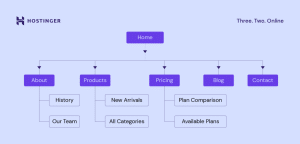The Main Purpose of an XML Sitemap: Enhancing Website Visibility and SEO
Web developers and SEO specialists are constantly looking for new ways to improve the visibility of websites and to better search engine optimization (SEO) in order to keep up with the ever-changing environment of digital marketing and online presence. The XML sitemap is an important implement that is included in this arsenal. Within the scope of this essay, we will investigate the primary function of an XML sitemap, gaining a knowledge of its significance, and analyzing the ways in which it helps to the overall performance of a website. What is the main purpose of a XML sitemap?

Understanding XML Sitemap: A Blueprint for Search Engines
An XML sitemap is a file that acts as a blueprint for search engines, directing them through the structure of a website and assisting them in comprehending the content of the page. A standard file format that is readable by machines is referred to as Extensible Markup Language (XML), which is also the name of the acronym. XML, in contrast to HTML, was not developed for the purpose of presentation but rather for the streamlined interchange of information.
During the process of crawling a website, a search engine will follow the links that lead from one page to the next. On the other hand, there are some pages that might be difficult to find, particularly if they are buried deep inside the architecture of the website or whether they do not have any external links. In this particular instance, the XML sitemap is of utmost importance.
The Main Purpose of an XML Sitemap
In order to supply search engines with a detailed map of the structure of a website, the major objective of an XML sitemap is to accomplish this. It guarantees that search engines are able to identify and index all relevant sites in an effective manner by providing this information. The following are some of the most important reasons that illustrate the significance of XML sitemaps:
1. Improved Crawling Efficiency
In order to crawl and index the huge expanse of the internet, search engine bots have a limited amount of time and resources at their disposal. Search engines are able to prioritize pages based on their importance with the assistance of an XML sitemap. Through the provision of a road map, the sitemap enables search engines to crawl and index the most important pages first. This ensures that the most important material is included in search engine results as frequently as possible.
2. Inclusion of Non-Linked Pages
Some of the pages on a website are not immediately connected from other sites on the website. Orphaned pages are pages that are not available to users and can only be accessed through certain user activities. A more thorough representation of a website’s content in search engine results can be achieved through the use of XML sitemaps, which serve as a bridge that enables search engines to locate and index sites that are not referred to by other pages.
3. Frequency and Priority Indication
The proprietors of websites are able to supply more information to search engines about the frequency of changes and the priority of particular pages through the use of XML sitemaps. Search engines are able to better identify which pages should be crawled more regularly with the use of this information. This helps to ensure that new content is indexed and displayed in search results as quickly as possible.
4. Facilitating Large and Complex Websites
When it comes to large websites that have complex structures, it can be difficult for search engine bots to navigate and locate these websites. In order to facilitate the crawling and indexing processes for search engines, XML sitemaps act as a guide that simplifies the procedure. E-commerce websites, news portals, and other content-rich platforms that have a large number of pages can benefit tremendously from this feature that is particularly advantageous.
Implementing XML Sitemaps for SEO Success
Now that we have a better understanding of the primary functions of an XML sitemap, let’s investigate how to implement and improve it such that it provides the greatest possible benefits to search engine optimization.

1. Generating a Comprehensive Sitemap
In the first step of the process, you will need to create a detailed XML sitemap that contains all of the pages of the website that are pertinent. XML sitemaps may be easily created and automatically updated with the help of a variety of tools and plugins that are available for major content management systems (CMS) such as WordPress. https://www.sitecentre.com.au/blog/html-sitemap-vs-xml-sitemap
2. Submitting Sitemaps to Search Engines
Following the generation of the XML sitemap, it is strongly recommended that it be published to major search engines such as Google and Bing. This can be accomplished by utilizing the webmaster tools provided by the respective search engine. By publishing the sitemap, website owners ensure that search engines are aware of the presence of the sitemap and are able to crawl and index the pages that are mentioned in an effective manner.
3. Regularly Updating the Sitemap
Content is frequently added, changed, or withdrawn from websites, making them dynamic entities that are constantly evolving. It is necessary to update the XML sitemap anytime there are substantial changes to the structure or content of the website. This will ensure that the sitemap continues to function effectively with the website. It is important to ensure that search engines have the most up-to-date information about the website by performing regular updates.
4. Monitoring Sitemap Performance
The performance of the XML sitemap should be carefully monitored on a regular basis by webmasters using the webmaster tools that are made available by search engines. There may be crawl faults, indexing problems, or other difficulties that could potentially influence the usefulness of the sitemap. This includes screening for these issues. When these difficulties are addressed as soon as possible, it guarantees that the website will continue to gain the highest possible visibility in the results of search engines.

Conclusion
Within the field of search engine optimization (SEO), an XML sitemap stands out as a powerful tool that makes a major contribution to the visibility and performance of a website within the results of search inquiries. An XML sitemap serves to improve the efficiency of crawling a website by giving a structured map of the content of the website. It also guarantees that non-linked pages are included, and it enables webmasters to convey to search engines the significance of modifications and the frequency with which they occur.
An essential component of any search engine optimization plan should be the implementation and optimization of XML sitemaps. This is especially true for websites that have complicated structures or that alter their content frequently. When it comes to maintaining and boosting a website’s search engine position and general online presence, it is crucial to be proactive in optimizing tools such as XML sitemaps. This is because search engines are constantly evolving, and this is becoming increasingly important.





